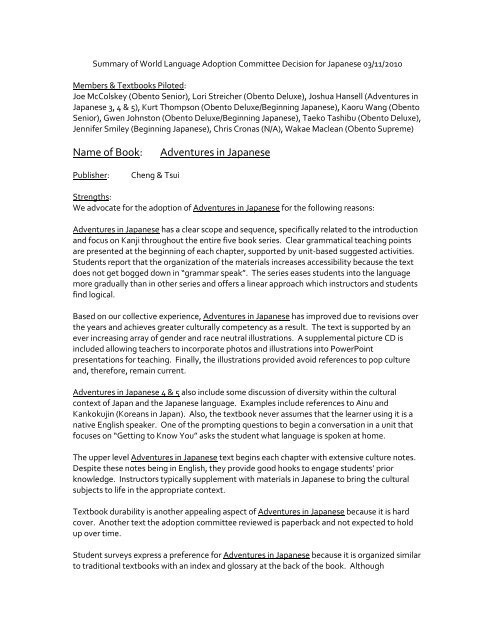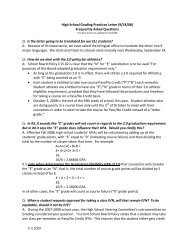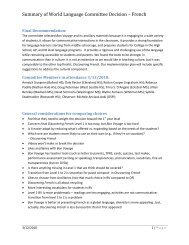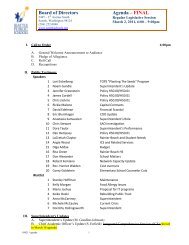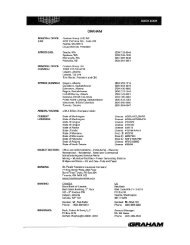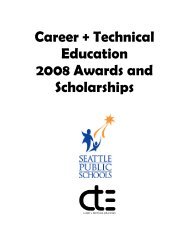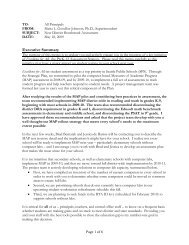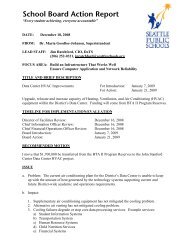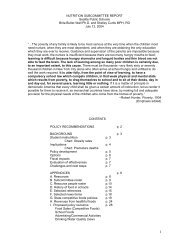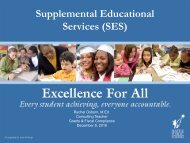Japanese - Seattle Public Schools
Japanese - Seattle Public Schools
Japanese - Seattle Public Schools
Create successful ePaper yourself
Turn your PDF publications into a flip-book with our unique Google optimized e-Paper software.
Summary of World Language Adoption Committee Decision for <strong>Japanese</strong> 03/11/2010<br />
Members & Textbooks Piloted:<br />
Joe McColskey (Obento Senior), Lori Streicher (Obento Deluxe), Joshua Hansell (Adventures in<br />
<strong>Japanese</strong> 3, 4 & 5), Kurt Thompson (Obento Deluxe/Beginning <strong>Japanese</strong>), Kaoru Wang (Obento<br />
Senior), Gwen Johnston (Obento Deluxe/Beginning <strong>Japanese</strong>), Taeko Tashibu (Obento Deluxe),<br />
Jennifer Smiley (Beginning <strong>Japanese</strong>), Chris Cronas (N/A), Wakae Maclean (Obento Supreme)<br />
Name of Book:<br />
Adventures in <strong>Japanese</strong><br />
Publisher:<br />
Cheng & Tsui<br />
Strengths:<br />
We advocate for the adoption of Adventures in <strong>Japanese</strong> for the following reasons:<br />
Adventures in <strong>Japanese</strong> has a clear scope and sequence, specifically related to the introduction<br />
and focus on Kanji throughout the entire five book series. Clear grammatical teaching points<br />
are presented at the beginning of each chapter, supported by unit-based suggested activities.<br />
Students report that the organization of the materials increases accessibility because the text<br />
does not get bogged down in “grammar speak”. The series eases students into the language<br />
more gradually than in other series and offers a linear approach which instructors and students<br />
find logical.<br />
Based on our collective experience, Adventures in <strong>Japanese</strong> has improved due to revisions over<br />
the years and achieves greater culturally competency as a result. The text is supported by an<br />
ever increasing array of gender and race neutral illustrations. A supplemental picture CD is<br />
included allowing teachers to incorporate photos and illustrations into PowerPoint<br />
presentations for teaching. Finally, the illustrations provided avoid references to pop culture<br />
and, therefore, remain current.<br />
Adventures in <strong>Japanese</strong> 4 & 5 also include some discussion of diversity within the cultural<br />
context of Japan and the <strong>Japanese</strong> language. Examples include references to Ainu and<br />
Kankokujin (Koreans in Japan). Also, the textbook never assumes that the learner using it is a<br />
native English speaker. One of the prompting questions to begin a conversation in a unit that<br />
focuses on “Getting to Know You” asks the student what language is spoken at home.<br />
The upper level Adventures in <strong>Japanese</strong> text begins each chapter with extensive culture notes.<br />
Despite these notes being in English, they provide good hooks to engage students’ prior<br />
knowledge. Instructors typically supplement with materials in <strong>Japanese</strong> to bring the cultural<br />
subjects to life in the appropriate context.<br />
Textbook durability is another appealing aspect of Adventures in <strong>Japanese</strong> because it is hard<br />
cover. Another text the adoption committee reviewed is paperback and not expected to hold<br />
up over time.<br />
Student surveys express a preference for Adventures in <strong>Japanese</strong> because it is organized similar<br />
to traditional textbooks with an index and glossary at the back of the book. Although
committee members agreed that students may use the index and glossary as a crutch at times,<br />
the value of having it outweighs the challenge of teaching students how to use the resources<br />
responsibly, which increases language accessibility.<br />
Because the Adventures in <strong>Japanese</strong> series has been used for a long time in a number of other<br />
districts, a web-based community of users exists that have developed additional materials<br />
specifically for the series. Of all the texts reviewed, Adventures in <strong>Japanese</strong> has a core of<br />
mature users that have developed their own supplementary materials over the years. The<br />
committee feels that the online community-based resources are invaluable in moving forward<br />
with Adventures in <strong>Japanese</strong>. In particular, the committee referenced Punahou School in<br />
Honolulu, HI, as having published online resources available to anyone who chooses to access<br />
them. The publishers are also offering professional development to teachers in the form of<br />
Webinars. Finally, the publisher offers teacher manuals that can be purchased separately from<br />
the textbooks.<br />
Concerns:<br />
The primary weakness of Adventures in <strong>Japanese</strong> is the audio CDs that accompany the<br />
curriculum. Few, if any, changes have been made to the audio recordings over the years.<br />
A major student complaint and concern among community members surveyed relates to the<br />
overall “look” of the text book. The publisher has done little over the last twenty years to<br />
improve the series’ visual appearance. The entire series generally lacks color or use of other<br />
graphic techniques such as font changes, tables, focus boxes, drawings, pictures, etc. The other<br />
two texts reviewed effectively employ these presentation techniques to engage students, show<br />
visual organization cues, appeal to multiple intelligences, provide authentic pictures of culture<br />
and life in Japan and use text features to highlight key information.<br />
Though the Adventures in <strong>Japanese</strong> textbooks are generally considered durable, quality control<br />
issues are present. One committee member reported that some books fell apart over the<br />
course of a school year from regular day-to-day use, as well as the occasional missing a chapter<br />
or two e.g. Chapter 1, 2, 3, 4, 7, 8, 9; Chapters 5 & 6 were not included.<br />
Another challenge that committee members identified is that the series focuses on student<br />
output. Students are not given enough listening and reading opportunities before being<br />
expected to produce writing or speak in <strong>Japanese</strong>. The series provides many opportunities for<br />
students to interact with one another or the group around a teaching point, but fewer<br />
opportunities to access authentic readings or listening sections – especially in comparison to<br />
the other textbooks we reviewed. The teacher manuals are also lacking in this area and offer<br />
little information or supplementary activities for practice.<br />
Overall, the series is lacking the richness that other texts offer and require supplementation<br />
with activities, reading, and listening sections found in the other materials we reviewed but<br />
cannot recommend for final adoption due to other issues.<br />
Conclusion:
Adventures in <strong>Japanese</strong> captures the breadth and depth of a curriculum that suits the needs of<br />
all learners we aim to reach. It is excellent for its scope, sequence and preparation for the AP/IB<br />
exams. And, despite its limitations, Adventures in <strong>Japanese</strong> presents the content of language<br />
that is needed for students in our highest level classes to perform well on the AP & IB exams,<br />
which, in turn, correspond to the expectations outlined by ACTFL intermediate low or middle<br />
level proficiency. The limitations can be addressed with supplementary materials – specifically<br />
in the areas of listening, authentic readings and native text and a greater variety of activities.<br />
Decision Based On:<br />
- Selection Criteria<br />
- <strong>Public</strong> Review Sheets<br />
- Survey – Community/Families (website)<br />
- Student Surveys (pilot)<br />
- Other input<br />
Name of Books:<br />
Obento Deluxe, Obento Supreme and Obento Senior<br />
Publisher: Nelson Pty Ltd. (a Cengage Company)<br />
Strengths:<br />
The Obento series is a visually appealing, somewhat engaging series of 3 textbooks that offers<br />
students culturally based manga, video and grammar explanations that are appropriate for<br />
middle school and lower level high school students. The series uses cultural examples that are<br />
current and in many cases interesting to students and presents <strong>Japanese</strong> culture as trendy and<br />
intriguing.<br />
Overall, students at the Middle School level preferred the Obento series to the Adventures in<br />
<strong>Japanese</strong> series. Many teachers also enjoyed teaching with the series, found the resources<br />
available helpful, and students found the listening comprehension activities easier to<br />
understand.<br />
Obento Deluxe is the first book in the series of 3 books and offers students an introduction into<br />
<strong>Japanese</strong> language and culture. Each lesson begins with a manga, includes new vocabulary,<br />
grammar explanations, cultural explanations and pair work activities. It provides easy to<br />
understand listening activities and a carefully sequenced program for teachers to follow. Each<br />
student workbook includes a CD-ROM with the videos (including skits and cultural clips),<br />
listening activities, and a frame-by-frame presentation of the manga for each chapter for<br />
students to listen to as they watch.<br />
Obento Supreme continues with the basic format of Obento Deluxe and offers manga,<br />
wordlists, activities, some kanji and grammar explanations with a higher level of difficulty. It is<br />
designed to look like a magazine and be appealing to students with interesting current pictures<br />
and a colorful layout. The workbook was also a helpful compliment to the text and the CD-<br />
ROM provided was once again a helpful component.
Obento Senior is the 3 rd and last book in the Obento series and is also very colorful and visually<br />
appealing. Obento Senior offers more difficult readings, more kanji (225 total by the end of the<br />
3 books) and is geared towards a slightly more mature <strong>Japanese</strong> language learner than the first<br />
2 Obento books. The workbook also includes a helpful grammar booklet.<br />
Concerns:<br />
The main concerns the adoption committee had with the Obento series focused around how it<br />
fit in with a rigorous AP/IB <strong>Japanese</strong> curriculum. In most cases teachers felt that each book did<br />
not offer enough material for a year’s worth of challenging curriculum and that the books would<br />
have to be supplemented substantially to accommodate for their lack of rigor. As a 3 year<br />
textbook series in a district with a <strong>Japanese</strong> program going through the 4 th and 5 th years, the<br />
material was insufficient and would clearly be inadequate to prepare students for the AP and IB<br />
exams. (The 225 kanji included in the series for example wouldn’t come close to the 410<br />
required for the AP exam.)<br />
The organization of the Obento series also had some issues. The organization was somewhat<br />
counterintuitive unless you carefully taught the material in the suggested way and because of<br />
this, made the incorporation of differing teaching methods (such as TPRS) more challenging.<br />
For independent study the books were also, in our opinion, harder to use because the glossaries<br />
and review sections were much less substantial than those found in Adventures in <strong>Japanese</strong>.<br />
It should also be noted that although the series was visually stimulating, some students felt the<br />
drawings were childish, and the visuals distracting because they were too busy. Another<br />
concern with having current cultural examples and photos provided in the textbook is that<br />
within a few years these would quickly become outdated and students are quick to notice this.<br />
Some other practical concerns committee members had were with the durability of the Obento<br />
books (all in the series are only available as soft-bound texts) and the cost. It is not realistic for<br />
soft-bound books to last more than a year in most cases and the $31 cost of each workbook that<br />
students would be expected to pay would not be feasible in many cases and would bring up<br />
equity issues.<br />
In addition, although it was helpful that the series offered a video component on the CD-ROM<br />
provided with each workbook , there were some glaring problems with the video. In particular<br />
the quality of the production was low, the heavy non-native accents of the actors were often<br />
difficult to understand, and in one case a video could be seen as homophobic.<br />
Another concern the committee had with the series was the introduction of both hiragana and<br />
katakana syllables at the same time and non-sequentially from the beginning of Obento<br />
Deluxe. In our experience students already have troubles confusing hiragana and katakana<br />
(because they have the same sounds) even when they are taught with a buffer of a few months,<br />
and teaching them at the same time could potentially exacerbate the problem.<br />
Proposal:
Although the Obento series does not fit the needs of a rigorous AP/IB <strong>Japanese</strong> program, as a<br />
committee we did feel that it could enhance the <strong>Japanese</strong> language curriculum if we could<br />
incorporate the best aspects of the series into our curriculum by purchasing a set for each<br />
school. In particular, we felt that the series would be especially helpful in our middle schools<br />
where the books were better received.<br />
Decision Based On:<br />
- Selection Criteria<br />
- <strong>Public</strong> Review Sheets<br />
- Survey – Community/Families (website)<br />
- Student Surveys (pilot)<br />
- Other input<br />
Name of Book: Beginning <strong>Japanese</strong><br />
Publisher: Tuttle<br />
Volume One of this 3 volume textbook series was first published in February 2010. Volumes 2<br />
and 3 are under development but are not expected to be available during this Textbook<br />
Adoption cycle. This fact alone was judged to be a “fatal” weakness that precluded the<br />
<strong>Japanese</strong> Adoption Committee from selecting the Tuttle textbook series as the finalist for<br />
adoption in 2010.<br />
Beginning <strong>Japanese</strong> was used in trial teaching at Washington and Eckstein Middle <strong>Schools</strong> and<br />
at Garfield and Roosevelt High <strong>Schools</strong> for 3-6 days. Student survey responses after these trials<br />
reflected observations from parent feedback (Eckstein families provided feedback on the<br />
textbooks)<br />
Strengths:<br />
- Written in accordance to National Standards for <strong>Japanese</strong> under ACTLF guidelines.<br />
- Designed to prepare students for the tasks they are expected to accomplish in the AP<br />
<strong>Japanese</strong> Exam from the beginning levels.<br />
- Designed for incorporation of technology use of <strong>Japanese</strong>.<br />
o<br />
o<br />
Early introduction to typing in <strong>Japanese</strong>.<br />
Assignments are included which require email writing, texting, and use of voice<br />
files sent by telephone or internet to teacher.<br />
- Colorful shading and text features on pages are used to highlight different types of<br />
content.<br />
- Manga presentation of key conversation patterns which fit into a continuing story<br />
involving the characters throughout the text.<br />
- Each unit has excellent index and glossary of the vocabulary introduced. Also material<br />
also presented again in the back of the text.<br />
- Vocabulary introduced is greater than in Adventures in <strong>Japanese</strong> Vol 1.<br />
- FURIGANA is printed below KANA and KANJI in horizontal text presentations in order<br />
to de-emphasize it role as the eye focus more on superscript than on subscript.
- KANJI is introduced earlier than in Adventures in <strong>Japanese</strong> or Obento and in greater<br />
numbers. The design is to introduce all AP (targets KANJI within the three text series).<br />
- KANJI is introduced for reading recognition first and later for writing production. As in<br />
Japan, use of FURIGANA follows the principle of more use when new terms are<br />
introduced, or terms are not part of key learning targets, and then use is reduced and<br />
eliminated as terms are cycled in following sections<br />
- Text reading segments are closer to what native speakers would be exposed to than<br />
found in either Obento or Adventures in <strong>Japanese</strong>.<br />
- Listening files have all native speakers even when the speaker is a non-native <strong>Japanese</strong><br />
in the script. Speaking speed is native like but struck students as too fast since there<br />
were no built in pauses.<br />
- Kiara’s Journal is written in a mix of <strong>Japanese</strong> and English that increasingly uses<br />
<strong>Japanese</strong> script as her stay in Japan extends. This illustrates a growing ability to use the<br />
language in writing about her experiences and discoveries while living in Japan over<br />
time. Rich in Cultural content and explanations from American perspective.<br />
- Cultural Box sections have richer explanations of culture of Japan relevant to the 21s<br />
Century Japan while Adventures in <strong>Japanese</strong> are often locked into cultural elements<br />
that were more prominent 10-25 years ago.<br />
- The activities included for practice with the language has greater variety and<br />
application than in other texts.<br />
- Textbook comes with a CD which has audio files for all dialogues and listening activities<br />
and tests for each unit.<br />
Concerns:<br />
- Grammar explanations used more “meta-language” and organization seemed more<br />
confusing than that in Adventures in <strong>Japanese</strong> for many students.<br />
- Listening CD files were limited to two or three per unit.<br />
- Listening files could not be stopped or paused when they started. There was no way to<br />
build in “pauses” for students to process what they heard.<br />
- Textbook had largest volume of content presented which seemed intimidating to first<br />
year students<br />
- All three major scripts of <strong>Japanese</strong> are presented for reading from the first page. This is<br />
overwhelming for most students in 1st level classes.<br />
- It seems that a working ability to read at least HIRAGANA is needed before students<br />
can begin working with the texts presented.<br />
- Website for supplemental materials for students and teachers is still under<br />
development.<br />
- Teacher supplemental materials are under development.<br />
Decision Based On:<br />
- Selection Criteria<br />
- <strong>Public</strong> Review Sheets<br />
- Survey – Community/Families (website)<br />
- Student Surveys (pilot)<br />
- Other input
Request for Adoption:<br />
The committee believes that the Adventures in <strong>Japanese</strong> series offers a more solid foundation<br />
for a 4 to 5 year <strong>Japanese</strong> language program than any of the other textbooks we examined.<br />
Although the other textbooks were initially appealing to both teachers and students, upon a<br />
closer examination, we found them to be lacking in essential areas. In particular, there simply<br />
was not enough material to support a program striving for excellence at all levels and guiding<br />
students towards success on the AP and IB exams and, ultimately, fluency in <strong>Japanese</strong>.<br />
However, with the committee recommendation to adopt Adventures in <strong>Japanese</strong>, there is no<br />
perfect textbook series and, as such, we request the adoption of additional curricula to support<br />
the use of Adventures in <strong>Japanese</strong>. Because the quality of the CDs for Adventures in <strong>Japanese</strong><br />
are poor, it is not as visually appealing to students and access to authentic readings or listening<br />
sections are lacking - especially in comparison to the other textbooks we reviewed - the<br />
committee would like teacher copies of the Obento Series and the Beginning <strong>Japanese</strong> series.<br />
That would include teacher manuals and workbooks (which include CDs) for each <strong>Japanese</strong><br />
teacher in the district to go along with the adoption of Adventures in <strong>Japanese</strong>.<br />
District Resource Library:<br />
- Obento Deluxe Teacher’s Resource with CD’s $235.95<br />
- Obento Supreme Teacher’s Resource with CD’s $235.95<br />
- Obento Senior Teacher’s Resource with CD’s $235.95<br />
- Adventures in <strong>Japanese</strong>’s teachers edition for each level (vol. 1 – 4) $351.80<br />
* Each manual is $87.95 each<br />
It is requested that each high school <strong>Japanese</strong> program will be provided with<br />
- Further Adventures in <strong>Japanese</strong> $45.00<br />
- Strive for a 5 $26.99<br />
- Adventures in <strong>Japanese</strong> Vol. 1 & 2 Image CD $43.95<br />
- Adventures in <strong>Japanese</strong> Vol. 1 Multimedia CD $24.95<br />
- Adventures in <strong>Japanese</strong> Vol. 2 Multimedia CD $32.95<br />
- Obento Deluxe Student Book (w/2CD’s) and Workbook (w/2CD’s) $80.90<br />
- Obento Supreme Student Book (w/2CD’s) and Workbook (w/2CD’s) $80.90<br />
- Obento Senior Student Book (w/2CD’s) and Workbook (w/CD’s) $82.90<br />
- Beginning <strong>Japanese</strong> student book (w/CD) and Workbook $100.00<br />
It is requested that each Middle school program be provided with:<br />
- Adventures in <strong>Japanese</strong> Vol. 1 Teachers edition $87.95<br />
- Adventures in <strong>Japanese</strong> Vol. 1 & 2 Image CD $43.95<br />
- Adventures in <strong>Japanese</strong> Vol. 1 Multimedia CD $24.95<br />
- Adventures in <strong>Japanese</strong> Vol. 2 Multimedia CD $32.95<br />
- Obento Deluxe Student Book (w/2CD’s) and Workbook (w/2CD’s) $80.90<br />
- Beginning <strong>Japanese</strong> student book (w/CD) and Workbook $100.00


